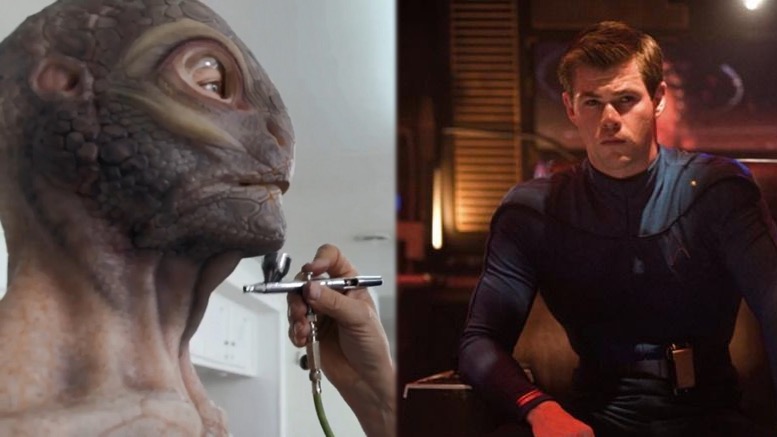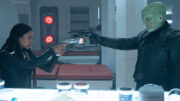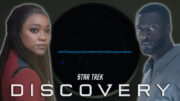This week on the Shuttle Pod, your podcast crew discuss the exciting news that came out last week.
Subscribe to Shuttle Pod: The TrekMovie.com Podcast on iTunes, Google Play Music and Pocket Casts! Like what you hear? Please feel free to leave us a glowing review on iTunes.
Shuttle Pod 48: Our First Look At ‘Star Trek: Discovery’ Season Two And Two More Trek Movies
|
In the same week we got a quick look at the start of production on Star Trek: Discovery season two, and then official confirmation that Paramount was planning not just one, but two, feature films. Brian, Jared, and Matt discuss. We were excited to get a glimpse at the USS Enterprise crew uniforms on Discovery, and that both the fourth Kelvin movie, with Chris Hemsworth returning as George Kirk, and the separate Quentin Tarantino project will be allowed to move forward.
Lastly, the crew indulges Matt in a little soapbox speech about placing The Original Series in its proper context to help reframe the current pop culture idea that TOS was “cheap.”
VIDEO: Visual effects artist Daren Dochterman (who worked on the Director’s Edition of Star Trek: The Motion Picture among other projects) used the blue screen footage found on The Roddenberry Vault to show off how nice the model work on TOS can look, even just by taking raw behind the scenes/deleted footage and compositing it into a star-field.







Imagine traveling back in time to meet your Australian dad and finding out he’s … … A SAURIAN.
Average episode budget, taken from Trek Myths website:
$250,000 — Land of the Giants (1968–1970)
$210,000 — Space:1999 (1975–1977)
$185,000 — Star Trek (1966–1969)
$180,000 — Mission: Impossible (1966–1973)
$140,000 — Lost in Space (1965–1968)
$120,000 — The Outer Limits (1963–1965)
There is, of course, quibbling to be made over this. For instance, Mission: Impossible was allowed to go over budget more so than Star Trek.
Probably because they saw a future for Mission: Impossible that didn’t see in Star Trek. The wonderful irony is that Star Trek and Mission: Impossible are the only two franchises making money for Paramount these days.
Denny C,
For the moment, the only thing making money for Paramount is A QUIET PLACE which got a sequel greenlit. Apparently Paramount is expecting another PARANORMAL ACTIVITY?
You’re definitely right about that one. They made it on the cheap and it earned a pile of cash AND good reviews. Here’s hoping it doesn’t become a franchise. They got it right the first time.
‘Mission’ had one more soundstage to shoot on than Trek, too.
(That budget, btw, is for Trek’s second season. The first season budget was more like $192K per episode. Of course, contrary to Roddenberry’s fervent promises, Trek was notorious for going over-budget on a consistent basis. The price tag for “The City on the Edge of Forever” was upwards of $250,000.00, making it the most expensive TOS outing ever aside from the pilots.)
Money well spent on that one. One hell of an episode.
That’s roughly $1.5 million per episode in adjusted dollars which was a huge sum in the 1960’s and roughly on par with the weekly budget for a TNG episode in the late 80s.
You’re wrong here.
185k was indeed a high budget for 1966, but it inflates to just 685k in 1986 dollars, meaning TNG had a budget more than twice that of TOS (reportedly it said budget as you says was 1.5m).
In 2018 185k is 1.5M meaning Discovery has a budget almost 5x that of TOS (it was reported somewhere that DSC has a budget north of 6M per episode).
By today’s standards TOS was cheap. In its day it was not. DSC is among the highest budgeted shows currently airing in terms of FX (rather than say House of cards which spends the majority of its budget on its high profile lead cast).
But a lot of this, as said, has a lot to do with the changing landscape of TV.
We’re talking 1960s television budgets which were notoriously tight since there was little money to be made after a series was cancelled. By the 1980’s and with the explosion of the home video market and more syndication dollars to be had, shows were now viewed as a long term investment which meant larger budgets, beefier contracts for the talent and so on.
When TNG launched Paramount knew that even a marginally successful television series would be like printing cash for years to come so a lot of money was put on the table when they gave it the green light.
You can’t compare the 1960’s television landscape to that of the 1980s. Compare it to other shows produced during that era and Star Trek’s was far from a low budget series and had to deal with challenges that your typical courtroom drama or western never had to deal with on a weekly basis. You need a horse? You got a horse. Need a shot of a car speeding down the street? You picked up a shot of a car speeding down the street. Star Trek? Need an alien that looks like lizard? You need to make a costume with very limited time available to pull it off. Need to show the Enterprise confronting a Romulan Warbird? You need to construct the model, storyboard the whole thing and then shoot new visuals.
It was a sophisticated series limited by budgets of that era and the technology of the time but it was not a low budget series.
It was a sophisticated series limited by budgets of that era and the technology of the time but it was not a low budget series.
That is a nicely phrased, and more succinct, version of what I was trying to get across in the podcast :-)
Well, that’s how it came across to me. ; )
Straight inflation doesn’t work for film and tv because the rates for labor and all sorts of other things escalate at different rates. Look at average cost for a feature and how it escalated in that same period.
Right and budgets were actually touted after the success of Star Wars. When Battlestar Galactica was released in theaters in 1979 (in SENSURROUND!) the budget became part of the marketing campaign, with ads exclaiming “TWO YEARS IN THE MAKING, PRESENTED AT A COST OF $14 MILLION”. Of course that $14 million was for the pilot and all eps produced that season but, hey, that was an obscene amount of money and if they weren’t going to get it back they could at least let people know that they spared no expense. In the end Universal did get their money back from an unsuspecting public who paid to see what they had watched for free on just 9 months earlier.
Big budgets became a badge of honor.
I’m one of the suckers who paid to see BSG on the big screen (at an excellent, now-dead theater, Santa Clara’s Cinema 150, where I saw CLOSE ENCOUNTERS over & over and two reissues of 2001), and I think it makes me the rarest of viewer, because it means I actually saw all four of the movies released in Sensurround in a cinema.
For the record, EARTHQUAKE, whatever its other faults, was spectacular in Sensurround, while Galac, ROLLERCOASTER and MIDWAY were just awful. In MIDWAY, the explosions occurring in the distance had the same level Sensurround effect as the close-in hits, whereas the effect in EARTHQUAKE was varied and impressive and even more than a little scarey. The effect was so tame in ROLLERCOASTER and GALACTICA that it carried no weight at all for me.
A lot of wasted potential with that effect, a movie that needed another gimmick (like, say, ARMAGEDDON) could have done wonders with it.
Truth be told, the only reason I didn’t see it in a theater was because my father wouldn’t take me, saying it sure looked like the same thing we saw on TV back in September. “But it’s not! And it’s in Sensurround and they say Baltar dies!” He said no to “Airport ’79”, too so, looking back, his instincts were spot on back in the day.
ROLLERCOASTER. Oh, man. After JAWS Universal was throwing money at just about anything that had the potential to be a blockbuster.
GALACTICA would seem to make sense for Sensurround on paper but the sound design was for mono playback in a TV movie. There wasn’t a lot to work with there.
I did not see BSG in the theater because I though it just looked amazingly terrible. And this was coming from someone who saw Star Wars many times at the theater and was a huge Trek guy already. And I was 13 when BSG hit the screens. An age range they were obviously counting on.
Sensaround did work for Earthquake. Rather well. Not so much for Rollercoaster or Midway. For Midway, I often didn’t even notice it, to be quite honest. BTW, kmart, I tihnk Santa Cruz had one theater equipped for sensaround. Also, the theaters I loved to go to are all now gone. The last one died about 4 years ago. The Century Dome on Winchester in San Jose. RIP.
I saw more movies at the San Jose Century theaters than anyplace else in my life (except maybe the Meridian Quad — later, incongruously, the Meridian Quad 6, when they cut two of the four theaters in half.) Knowing that is gone makes me even less likely to visit back home (haven’t been there in over 15 years.) Then again, I’ve seen less movies in the theater this whole century than I did in any single year of my life during the 20th century, and a decent number of those were reissues, not new releases.
The irritating thing is the 5 domes (one of them is two screens under one dome, I never went to that one) are still just sitting there. Including the superior 22 and 23. It’s been a big parking lot. The owners said they wanted to use it in a way better than a few large screen theaters could but nothing has happened since the closure. At least they could have considered keeping it going until it was certain what was going to happen to the property.
I’m trying to wrap my brain around the idea that someone gave Irwin Allen $250,000 per episode for Land of the Giants.
I know right? Allen was cheap and reused anything and everything he could from one show to the next. It’s hard to see why it had a big budget. My only thought is that it was to accommodate all the optical effects of little people next to big people, but even then they kept that to minimum.
And big props. It wasn’t all stunts because the actors did a great deal of that. The opticals are a good guess because I’ve read Lost in Space had to be very careful to not use too many laser beam shots.
And the “Lost in Space” pilot looks great but as the series progressed you could tell that they were starting to cut corners.
THE TIME TUNNEL pilot looked pretty fantastic, and I saw part of it a few years back and it still held up. The first half, where they are showing off the Tunnel and the surrounding FORBIDDEN PLANET/KRELL-like facility housing it, are far more ambitious than anything I remember seeing on a television show for decades afterward.
But that kind of gets obscured when you mainly remember seeing people painted silver or gold and decked out in childish carrot costumes that look awfully papier mache.
And the shot-in-daylight crash from LOST IN SPACE is still among my favorite shots of that type, and I really dug seeing the flying sub from VOYAGE too (and the Seaview, a nouveau take on a glass bottom boat.)
That Lost in Space shot is fantastic and, yeah, the model work on Voyage was fantastic.
kmart,
Definitely agree with you on THE TIME TUNNEL pilot and the Gemini XII/Jupiter II money shot. In one of my box set collections I recall it revealed that last scene leading from the in atmosphere planetary flyover to the spaceship landfall wasn’t a one and done by the Lydecker Bros. They had some epic fails before they got that perfect take.
I guess those giant props didn’t come cheap or maybe it was just the showrunner…
Yeah, Irwin Allen was a frugal kind of guy and had no problem sacrificing good storytelling for easy ratings (I’m looking at you, Voyage to the Bottom of the Sea). He was the anti-Roddenberry,
Matt Wright,
Near as I can recall there was no recycling in the creation of the oversized props used to make the Earth people diminutive standing near, crawling over and otherwise manipulating them. I recall on some studio tour (Universal?) being given the opportunity to crawl over the oversized dial phone and pose with other oversized objects that I recall as being from LAND OF THE GIANTS.
According to DECADES which is run by CBS in an arrangement somewhat akin to the one they have for the CW:
http://www.decades.com/lists/danger-here-are-12-far-out-facts-about-lost-in-space
“5. The set of the Jupiter 2 cost more than that of the Enterprise.
Sure, the producers recycled, but they were not cheap. The set of the Robinsons’ craft ran a bill of $350,000 — about $2.5 million in today’s bucks. Not too bad, really. In the story of the show, the nifty flying saucer supposedly cost $30 billion.
…
10. The Robot costume weighed about 200 pounds and cost $70,000.
That’s around half a million in today’s cash. The robot was designed by Robert Kinoshita, who also designed the iconic Robby the Robot and Tobor. In 1965, stuntman Bob May was rehearsing on a studio lot, working as a double for Red Buttons, when Irwin Allen spotted the physically gifted performer. Allen told May that if he could fit into the costume, the role of Robot B-9 was his on Lost in Space. Fortunately, May fit inside the fiberglass suit. In the earlier designs, May would have had to trigger the lights on the Robot’s torso by hitting a button inside the suit with his head. The button was eventually moved down by the claw.” — ”Danger! Here are 12 far-out facts about ‘Lost in Space”’ By: Decades Staff Posted: June 14, 2017 Site: Decades.com
Very cool. Thanks for sharing.
It may look cheap by todays standards, but don’t forget the saying “never judge a book by its cover”. Some of those stories were absolute classics and still hold up fairly well and of course the characters are iconic now. Personally I find people who are too stuck up on effects and things looking pretty to be very shallow people.
Trust me on this, if nothing else: Franz Joseph’s Enterprise blueprints and The Starfleet Technical Manual didn’t both become huge best-sellers for Pocket Books back in the ’70s because we thought at the time that the source material looked cheesy or low-budget.
Exactly.
Well Said!
Yep.
Hear, hear! Couldn’t have said it better!
“Mm, I love classic 23rd century design. Black finish, silver highlights…”
Me too! I’ve often wondered if being a fan of the Silver&Black Oakland Raiders (but only when ‘the mad bomber’ Daryle Lamonica was their QB, before Stabler) contributed to my subliminal appreciation of the monochrome prop pallet on TOS, but more likely it is just a choice that really has always worked for me.
I look around in my toolbox, and most things are stainless steel, with the occasional black handle. There’s a logic to Wah Chang’s props, they look like tools, robust and functional. The new gadgets and gizmos in recent productions, however, remind me of the ubiquitous cell phones–flashy but fragile, and prone to crashing at inopportune times. If I’m going into space, I want the simplest, most durable and robust tools available. I don’t want glitchy overthought technological fads.
I agree. And it seems there are oh so many shallow people. They watch TOS and all they perceive are dated effects, not timeless stories.
Iam so tired of all the Discovry and Spock hate on the shuttle pod. i would love to see Spock and Pike as a major player in season two of discovery. i also think another actor could play spock. Quinto did a good job, so could another Actor. Its like all the TNG fans are jealious that TOS is getting some love and attention.
I gotta say that I am right there when people claim TOS is “cheap”. Hardly. Yes, it’s dated 50 years later. And I agree it was dated even 15 years later. But that was just the look. The writing and the tone far more often than not hit the ball right on the screws. For TV in it’s time, it was indeed something that TV had never seen or done before. And it was certainly not done on the the “cheap”. These things always need to be looked at for the time it was in.
Excellent points Matt, LLAP.
I just want to say: THANK YOU for that second half and additional material concerning TOS budgets and whatnot. I’m sick and tired of people lambasting the perceived general cheapness, “campiness” or goofiness of TOS. To me, what TOS boils down to is a great number of really really fine stories – some “pure” science-fiction, some highly aware social commentary – told in the “mode” of 1960s television, NOT “cheap television”. And I also always found that there was a nicely understated beauty and elegance to that show’s visual style. Of course these days you can’t put someone in a shower curtain and pretend that it’s a radiation suit – but no one would expect that from a production like Discovery. But to me, on the other hand, the real “futuristic” part about it all was always the simple and streamlined look of sets and props (even more so in TNG, mind you). No matter what set or prop: The simpler it looked, the more functional it appeared to me. And that’s what I don’t really “get” about DISCO’s production design. When I first saw the DISCO tricorder prop, I rejoiced, because it had just the right mixture of ruggedness and streamlinedness (is that even a word?) to it and I said: “Yes, that looks like a functional piece of equipment.” But from then on, the more I got see of that series, the more I felt that they were going for an “overkill” vibe. Visual information overkill, blinkenlights overkill, holo-gadget overkill etc. It all culminated in the super-ornate (yet butt-ugly IMHO) Klingon ship designs to which there was just no rhyme or reason, but in a lot of ways the same is true for what I’m gonna call “Blue Starfleet”.
Note: I was typing this while I was still listening. I just noticed that you brought up a lot of those exact points as you went along.
Shuttle Pod Crew,
While I agree with you, if we want to give the topic of STAR TREK doing it on the cheap a fair shake, should not there be some discussion about the use of the Aluminum Model Toys Company’s plastic model kits in THE DOOMSDAY MACHINE and THE TROUBLE WITH TRIBBLES? And I seem to recall the damaged AMT USS Constellation footage was reused from Doomsday to indicate a battle damaged Starfleet ship in at least one other episode that escapes me for the moment.
Yeah, there’s a stock long shot from DOOMSDAY reused for a viewscreen image in ULTIMATE COMPUTER after Enterprise kills the EXCALIBUR. AT least I think it is, there is a flash (indicating phaser hit) at the start of the shot that wasn’t there in the other episode.
kmart,
Re: AT least I think it is
I think you got got it. I recall that’s the episode or at least one of them.
I suppose this discussion should lead into kitbashing as well. I think they used some AMT Enterprise model parts to modify a Tholian ship into Severin’s ship in WAY TO EDEN.
Actually, they used parts from the Klingon ship model kit (which had probably gone on sale just months before) to stand in for the Aurora’s overloading engines.
Shoddiest trek related kitbash I can recall is a Canadian cheapie called THE SHAPE OF THINGS TO COME that turned up stateside right after TMP. Main human characters and their obligatory robot sidekick spend middle of film traveling through space in something that is just some K-7 Pods from TRIBBLES. Movie also features a scene set on the moon that is shot outside a geodesic dome structure in normal earth daylight that had me giggling. O god is it a bad movie. Has a nice spaceship crash at beginning that was done by STAR WARS pyro guy Joe Viskocil, who also deliver a SPACE1999+ blast for the end of the movie.
Michael Hall,
I don’t know about that. It sure looks more like a modified Enterprise warp pod to me stuck on it:
http://www.ex-astris-scientia.org/schematics/aurora-t.jpg
Just getting around to listening to Shuttle Pod 48. Very good info and always lots of fun to listen to. Anyways, I know you guys are protective of TOS and I guess that it wasn’t cheap but some of the effects look, as you said, “dated” and cheap-looking. Wow $600K plus for The Cage??!! Well most of it looks great but the Phasor Cannon scene looks like effects from a bad 1950s monster movie and the fly away from Talos IV and the subsequent flyby and far shot of the Enterprise at the end of the show really look terribly cheap, even for $600K. It is also always fun to watch the Gorn and fake boulders in Arena haha!! That said, I do however love the orbiting Enterprise shots – IMO they are superior to the CGI effects used in the remastered episodes. Anyways always good to listen. Thanks!